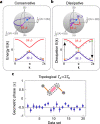Non-Abelian effects in dissipative photonic topological lattices
- PMID: 36922499
- PMCID: PMC10017693
- DOI: 10.1038/s41467-023-37065-z
Non-Abelian effects in dissipative photonic topological lattices
Abstract
Topology is central to phenomena that arise in a variety of fields, ranging from quantum field theory to quantum information science to condensed matter physics. Recently, the study of topology has been extended to open systems, leading to a plethora of intriguing effects such as topological lasing, exceptional surfaces, as well as non-Hermitian bulk-boundary correspondence. Here, we show that Bloch eigenstates associated with lattices with dissipatively coupled elements exhibit geometric properties that cannot be described via scalar Berry phases, in sharp contrast to conservative Hamiltonians with non-degenerate energy levels. This unusual behavior can be attributed to the significant population exchanges among the corresponding dissipation bands of such lattices. Using a one-dimensional example, we show both theoretically and experimentally that such population exchanges can manifest themselves via matrix-valued operators in the corresponding Bloch dynamics. In two-dimensional lattices, such matrix-valued operators can form non-commuting pairs and lead to non-Abelian dynamics, as confirmed by our numerical simulations. Our results point to new ways in which the combined effect of topology and engineered dissipation can lead to non-Abelian topological phenomena.
© 2023. The Author(s).
Conflict of interest statement
The authors declare no competing interests.
Figures





References
-
- Zurek WojciechHubert. Decoherence, einselection, and the quantum origins of the classical. Rev. Mod. Phys. 2003;75:715–775. doi: 10.1103/RevModPhys.75.715. - DOI
-
- Diehl S, Rico E, Baranov MA, Zoller P. Topology by dissipation in atomic quantum wires. Nat. Phys. 2011;7:971–977. doi: 10.1038/nphys2106. - DOI
-
- Verstraete F, Wolf MM, Ignacio Cirac J. Quantum computation and quantum-state engineering driven by dissipation. Nat. Phys. 2009;5:633–636. doi: 10.1038/nphys1342. - DOI
Grants and funding
LinkOut - more resources
Full Text Sources

